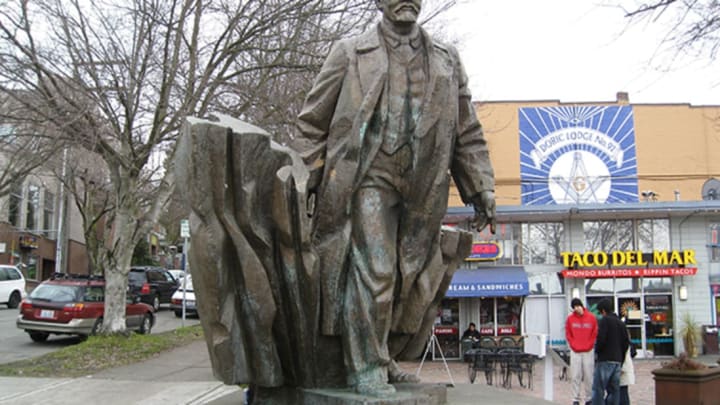If you'd like to experience the public art of the Soviet Union, there's no need to travel to Eastern Europe. In Seattle's artsy Fremont neighborhood, there’s a monument to Soviet leader Vladimir Lenin. Despite efforts by its owners to sell it off, it’s been in Washington since the collapse of the Eastern Bloc (first in Issaquah, before moving to Seattle in 1995).
Considering Lenin’s legacy of oppression and mass executions, the 16-foot, seven-ton bronze statue doesn’t sit well with all residents. It was originally brought to Seattle by Lewis Carpenter, a Washington resident who saved it from the scrapyards of Poprad, Slovakia. Arguing that it was a work of art that deserved to be preserved, he purchased it and brought it back to the U.S.
Carpenter died in 1994, not long after shipping the statue to Issaquah, Washington, where he planned to install it in front of a restaurant he was set to open. A year later, it made its way to Seattle, where it was displayed as a piece of public art, just one block south of the Rocket, another Cold War relic-turned-artwork. Carpenter’s family still owns the statue of Lenin, but would love to get it off their hands. There’s an entire Facebook page devoted to tearing it down, and it’s regularly vandalized by people who paint the statue’s hands blood red.
In 1995, the statue was put up for sale for $150,000, with the proceeds scheduled to benefit a local arts organization, but no buyer came forward. By 2015, the price had been raised to $250,000—or best offer, as the The Seattle Times reported. Whether it will actually ever be sold is another question.
“Who can say for sure if the community would accept a check for the sale of Lenin if offered? The sculpture has found a home in Fremont,” the Fremont Arts Council’s Barbara Luecke told mental_floss in an email. However, if anyone did actually want to pay the $250,000 that an art appraiser decided the statue was worth, “any proceeds from its sale would help with the maintenance of the various art projects around the neighborhood,” she says.
Until then, the statue serves as a handy guidepost for local directions (“keep going until you see Lenin” cannot be misunderstood), and occasionally gets new additions, like a tutu for the annual gay pride parade or a tinfoil-wrapped burrito to hold as an advertisement for the nearby Mexican restaurant.
Know of something you think we should cover? Email us at tips@mentalfloss.com.
